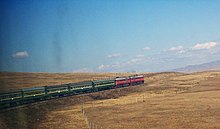Trans-Mongolian Railway: Difference between revisions
m Ouch, correct the redirect |
new from de:WP |
||
| Line 1: | Line 1: | ||
The '''Trans-Mongolian Railway''' is a side line of the [[Transsiberian Railroad]], which travels through [[Mongolia]] to [[China]]. It connects [[Ulan Ude]] over [[Naushki]] and [[Ulan Bator]] to [[Beijing]]. |
|||
#redirect [[Trans-Siberian Railway]] |
|||
[[Image:Ulaanbaatar_train_station.jpg|thumb|The main station of Ulan Bator]] |
|||
[[Image:Trans_mongolian_gobi.jpg|thumb|The Trans-Mongolian Railway in the [[Gobi Desert]]]] |
|||
Other important stops are in Mongolia [[Sükhbaatar (city)|Sükhbaatar]], [[Darkhan]], [[Choir (city)|Choir]], [[Sainshand]], [[Zamin-Uud]], in China [[Erenhot]] (border crossing and gauge switching station) [[Datong]], and [[Jining]]. The line was built between 1949 and 1961. In most of Mongolia it has a single track, in China two. The gauge is 1524 mm in Russia and Mongolia, and 1435 mm in China. Important side tracks leat to [[Erdenet]] and [[Bayan Nuur]]. |
|||
== History == |
|||
The first railroad line in Mongolia was the 43 km long stretch between Ulan Bator and [[Nalaikh]], which opened in 1938. In the same year, the line between [[Solovjosk]] and [[Bajantumen]] near [[Choibalsan (city)|Choibalsan]] (238 km) in eastern Mongolia was built. This line is connected to the Transsiberian Railroad in [[Borzja]], but has no connection to the main line in Mongolia. It only runs cargo traffic, and has narrow gauge extensions to [[Tamzag Bulag]] and [[Zuun Bulag]]. |
|||
In 1950 the northern connection from Russia to Nalaikh was finished. The southern connection from Ulan Bator to China opened in 1955. |
|||
== Operation == |
|||
[[Image:WheelChanging.jpg|thumb|right|235px|Changing the wheels from Mongolian gauge to Chinese gauge at the border]] |
|||
The Mongolian Railroad company ''Mongolyn Tömör Zam'' carries 80% of all cargo and 30% of all passenger transport within Mongolia. |
|||
After democratization the cargo traffic was reduced by about half, but had reached almost the original levels again by 2005. Passenger numbers reached the old levels again already in 2001 with 4.1 passengers. |
|||
Most trains are equipped with double locomotives to avoid costly breakdowns, which would cause serious economic disruption in a sparsely populated country covering huge distances. |
|||
Since Russia and Mongolia use [[broad gauge]] railways while China uses the [[standard gauge]], there is a [[break-of-gauge]], meaning that carriages to or from China cannot simply cross the border, and each carriage has to be lifted in turn to have its [[bogie]]s changed. The whole operation, combined with passport and customs control, can take several hours. |
|||
== External Links == |
|||
* [http://www.mtz.mn/ Mongolian Railroads] (Mongolian, Russian) |
|||
[[Category:Transportation in Mongolia]] |
|||
[[de:Transmongolische Eisenbahn]] |
|||
[[nl:Trans-Mongolische spoorlijn]] |
|||
[[ru:Монгольская железная дорога]] |
|||
Revision as of 00:36, 20 March 2007
The Trans-Mongolian Railway is a side line of the Transsiberian Railroad, which travels through Mongolia to China. It connects Ulan Ude over Naushki and Ulan Bator to Beijing.


Other important stops are in Mongolia Sükhbaatar, Darkhan, Choir, Sainshand, Zamin-Uud, in China Erenhot (border crossing and gauge switching station) Datong, and Jining. The line was built between 1949 and 1961. In most of Mongolia it has a single track, in China two. The gauge is 1524 mm in Russia and Mongolia, and 1435 mm in China. Important side tracks leat to Erdenet and Bayan Nuur.
History
The first railroad line in Mongolia was the 43 km long stretch between Ulan Bator and Nalaikh, which opened in 1938. In the same year, the line between Solovjosk and Bajantumen near Choibalsan (238 km) in eastern Mongolia was built. This line is connected to the Transsiberian Railroad in Borzja, but has no connection to the main line in Mongolia. It only runs cargo traffic, and has narrow gauge extensions to Tamzag Bulag and Zuun Bulag.
In 1950 the northern connection from Russia to Nalaikh was finished. The southern connection from Ulan Bator to China opened in 1955.
Operation

The Mongolian Railroad company Mongolyn Tömör Zam carries 80% of all cargo and 30% of all passenger transport within Mongolia. After democratization the cargo traffic was reduced by about half, but had reached almost the original levels again by 2005. Passenger numbers reached the old levels again already in 2001 with 4.1 passengers.
Most trains are equipped with double locomotives to avoid costly breakdowns, which would cause serious economic disruption in a sparsely populated country covering huge distances.
Since Russia and Mongolia use broad gauge railways while China uses the standard gauge, there is a break-of-gauge, meaning that carriages to or from China cannot simply cross the border, and each carriage has to be lifted in turn to have its bogies changed. The whole operation, combined with passport and customs control, can take several hours.
External Links
- Mongolian Railroads (Mongolian, Russian)
